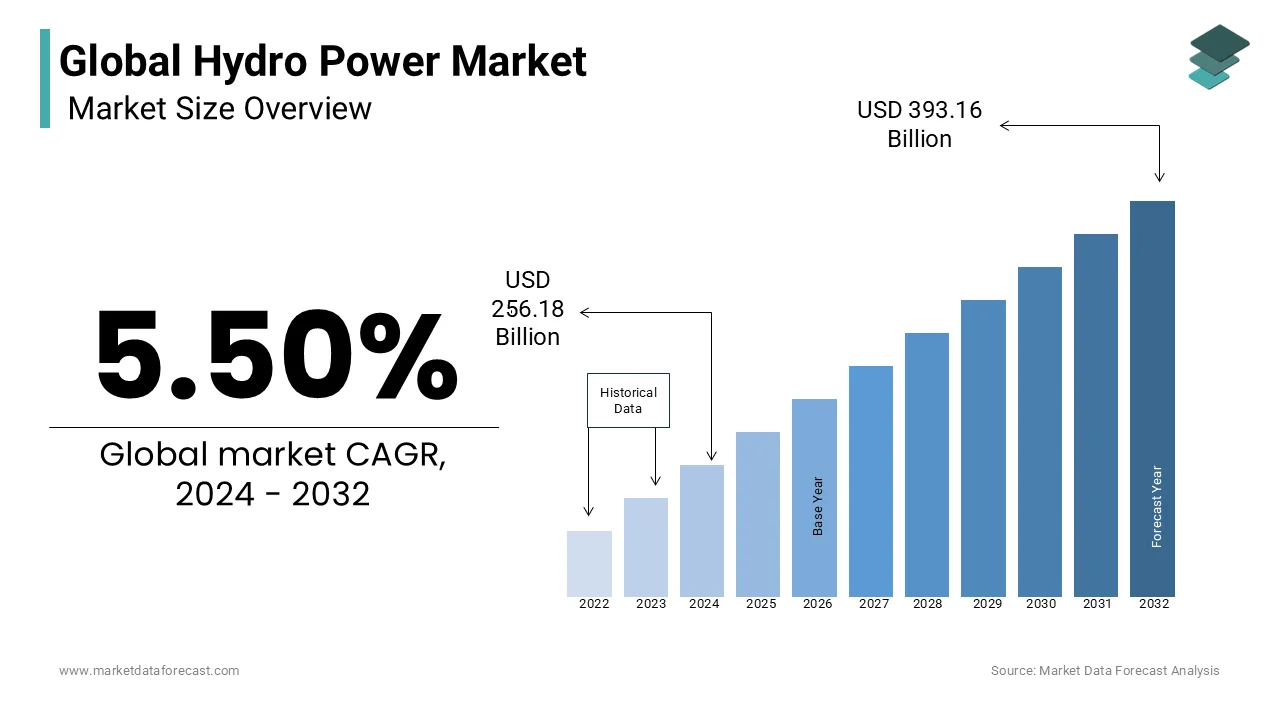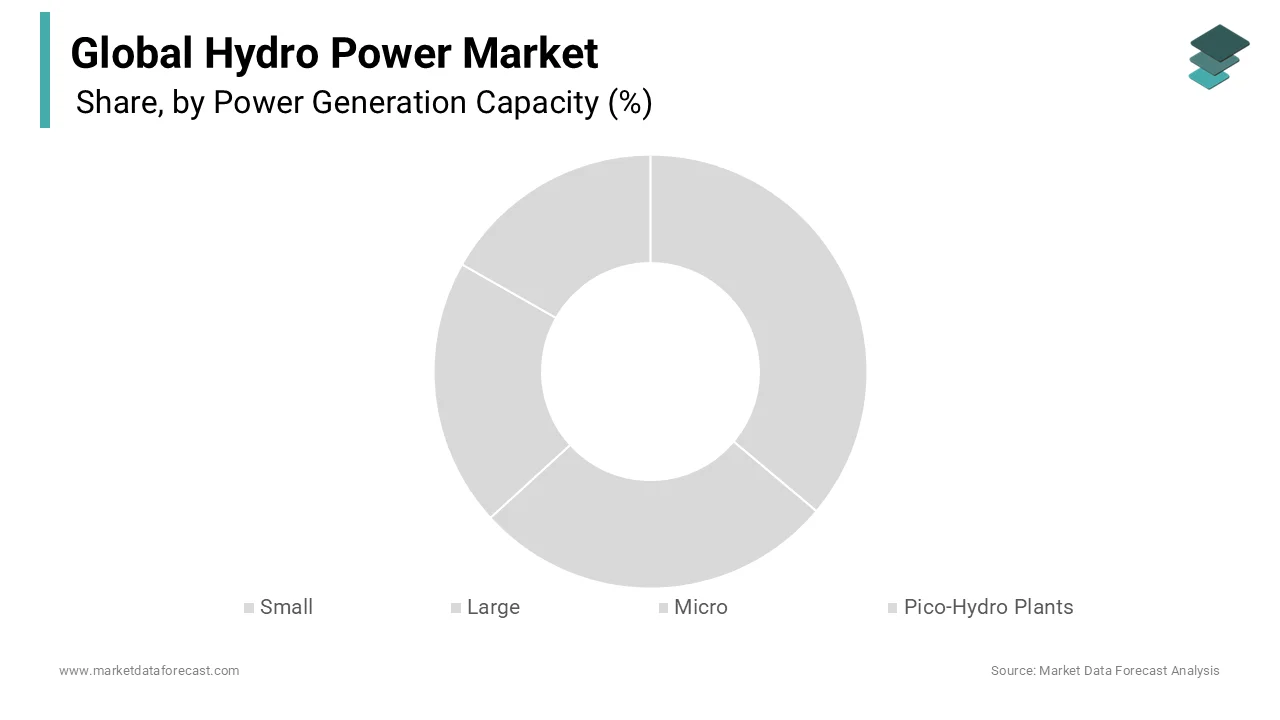Global Hydro Power Market Size, Share, Trends & Growth Forecast Report - Segmentation By Power Generation Capacity (Small, Large, Micro, Pico-Hydro) & Region - Industry Forecast From 2024 to 2032
Global Hydro Power Market Size (2024-2032):
The size of the global hydro power market was worth USD 242.83 Billion in 2023. The global market is anticipated to grow at a CAGR of 5.50% from 2024 to 2032 and be worth USD 393.16 billion by 2032 from USD 256.18 billion in 2024.

Current Scenario of the Global Hydro Power Market
Hydroelectricity is a clean, sustainable, and readily available source of energy with no negative effects on the environment. The amount of electricity produced by the hydroelectric plant depends on the amount of running water and elevation. In hydroelectric power plants, attached rotating blades convert kinetic energy into electrical energy generated by rotational motion. The hydroelectric power facility has seen steady expansion as it provides a more reliable, cleaner, and affordable electricity call, as many countries seek options to meet carbon emission reduction targets due to growing environmental concerns. It is one of the cleanest fuel sources that is regularly renewed through rainfall and snow. Hydropower is readily available because, depending on the call and requirements, engineers can control the flow of water using turbines, and reservoirs can also provide opportunities for recreation and activities such as boating and swimming. Also, hydropower is considered the cleanest renewable technology for power generation, making it even more attractive. Hydropower has received tremendous support from the governments of various countries in the form of tax breaks and financial incentives around the world due to these factors.
MARKET TRENDS
One of the most popular renewable energy generation technologies includes hydroelectricity, which does not emit greenhouse gases or toxic waste. After the construction of a dam and the installation of equipment, the source of energy, that is, running water, is free, therefore hydroelectric power is one of the cheapest ways to generate electricity. About a fifth of the world's total electricity comes from hydropower. It is employed by more than 60 countries around the world to meet half of their electricity call. Hydropower is also popular for a variety of reasons, some of which include water management, flood control, and its ability to respond to fluctuations in electricity calls.
MARKET DRIVERS
Rising attention to conversion efficiency derived from the adoption of renewable energy integration, along with its wide range of applications, including water supply for irrigation and flood control, will drive hydropower market expansion over the foreseen period.
Worldwide volatility in fossil fuel prices coupled with energy security initiatives will further complement the landscape of the hydropower industry. Hydropower is one of the oldest sources of energy that was employed thousands of years ago to turn the paddle wheels that help grind grain. Hydroelectricity is a versatile and sustainable technology, the world's largest renewable energy source, and currently represents around 20% of the world's total electricity supply.
MARKET RESTRAINTS
The high initial investment cost of hydroelectric infrastructure with safety concerns and the development of modern technologies with the launch of alternative products can restrict the worldwide hydropower market.
Although hydropower is a renewable energy source and is perceived to be environmentally friendly, creating new hydroelectric facilities has been difficult for industry players due to strict state and federal regulations and a lack of suitable locations. Furthermore, the recession caused the depletion of financing for large projects, which made it difficult for companies in the sector to start up. However, industry players have been keeping busy and upgrade plans are in the works. Industry players are looking to upgrade facilities as the call for electricity increases and water continues to flow.
MARKET OPPORTUNITIES
Technological advances and intensive research and development activities are estimated to create new opportunities for the expansion of the global hydropower market in the coming years. The low rate of civil construction combined with increased measures to limit carbon emissions will stimulate the market for small hydropower plants. With a favourable renewable energy policy model coupled with financial support from institutions, including climate-aligned bonds, Aquila Capital and the World Bank will lead small and large hydropower plants around the world. In 2015, the Economic Community of West African States (ECOWAS) introduced the Small Hydroelectric Power Plant (PEU) program with the goal of achieving 33% of the overall energy mix by 2020 as part of the program. ECOWAS Renewable Energy Policy (EREP). The total cost of small-scale hydropower is a crucial factor compared to other capacities, which will drive the world's small-scale hydropower.
MARKET CHALLENGES
The availability of alternative sources of natural and renewable energy production, such as solar and wind power, and non-renewable sources, such as natural gas and coal, are other factors likely to hamper the expansion of the target market in Africa during the envisioned period.
REPORT COVERAGE
|
REPORT METRIC |
DETAILS |
|
Market Size Available |
2023 to 2032 |
|
Base Year |
2023 |
|
Forecast Period |
2024 to 2032 |
|
CAGR |
5.50% |
|
Segments Covered |
By Power Generation Capacity, and Region. |
|
Various Analyses Covered |
Global, Regional & Country Level Analysis, Segment-Level Analysis, DROC, PESTLE Analysis, Porter’s Five Forces Analysis, Competitive Landscape, Analyst Overview of Investment Opportunities |
|
Regions Covered |
North America, Europe, APAC, Latin America, Middle East & Africa |
|
Market Leaders Profiled |
Missouri River Energy, GreenCollar Group, Pelamis Wave Power, GreenField Consulting, Water Conservation Specialist, China Three Gorges Corporation, China Datang Corporation, Dongfang Electric Corporation Limited, China Huadian Corporation, China Huaneng Group Corporation, Bharat Heavy Electricals Limited, The Tata Power Company, Jaiprakash Associates Limited, NHPC Limited, Uttarakhand Jal Vidyut Nigam Limited, Comision Federal de Electricidad, Andritz Hydro GmbH, and Statkraft AS, and Others. |
SEGMENTAL ANALYSIS
Global Hydro Power Market Analysis By Power Generation Capacity
Plants capable of generating electricity of more than 30 MW are considered large hydroelectric plants. The small hydroelectric power plant segment generally includes hydroelectric power plants with capacities between 100 kW and 30 MW, while micro and pico-hybrid plants have power generation capacities below 100 kW.
REGIONAL ANALYSIS
China has become the world's largest hydroelectric power-producing country and had the largest share in 2020 at 24.55%. Also, the rapid addition of capacity in China also makes it a favourable destination for hydroelectric power generation. China accounted for more than half of the complete hydroelectric capacity installed in the year 2012 to meet its rising energy call. The hydroelectric power market is also stimulated by various government instruments such as Feed-I rates (FIT) and renewable portfolio standards (RPS).

North America is also likely to post lucrative expansion rates during the outlook period due to the introduction of favourable regulations. India has one of the largest hydroelectric potentials in the world. Additionally, the government is taking initiatives to utilize the estimated potential in various unexplored areas. For example, the Brahmaputra river basin, which represents one of the largest hydroelectric potentials in the country, has been the most underutilized area for hydroelectric projects. US President Barack Obama passed the Hydropower Regulatory Efficiency Act and the Small Pipeline Hydropower Development and Rural Jobs Act in August 2021, which are supposed to increase hydropower capacity in the country. There is a development of new hydropower that has been followed by large investments in the regions, especially Africa, Asia, and South America.
KEY PLAYERS IN THE GLOBAL HYDRO POWER MARKET
Companies playing a prominent role in the global hydro power market include Missouri River Energy, GreenCollar Group, Pelamis Wave Power, GreenField Consulting, Water Conservation Specialist, China Three Gorges Corporation, China Datang Corporation, Dongfang Electric Corporation Limited, China Huadian Corporation, China Huaneng Group Corporation, Bharat Heavy Electricals Limited, The Tata Power Company, Jaiprakash Associates Limited, NHPC Limited, Uttarakhand Jal Vidyut Nigam Limited, Comision Federal de Electricidad, Andritz Hydro GmbH, and Statkraft AS, and Others.
RECENT HAPPENINGS IN THE GLOBAL HYDRO POWER MARKET
- The hydropower industry is launching a major international project to demonstrate its flexibility. Over the next four years, flexibility technologies will be tested in all three phases of the project.
DETAILED SEGMENTATION OF THE GLOBAL HYDRO POWER MARKET INCLUDED IN THIS REPORT
This global hydro power market research report has been segmented and sub-segmented based on power generation capacity and region.
By Power Generation Capacity
- Small
- Large
- Micro
- Pico-Hydro Plants
By Region
- North America
- Europe
- Asia Pacific
- Latin America
- Middle East & Africa
Frequently Asked Questions
1. What is the Hydro Power Market growth rate during the projection period?
The global hydro power market is expected to grow with a CAGR of 5.50% between 2024-2032.
2. What can be the total Hydro Power Market value?
The global hydro power market size is expected to reach a revised size of USD 393.16 billion by 2032.
3. Name any three Hydro Power Market key players?
GreenCollar Group, Pelamis Wave Power, and GreenField Consulting are the three hydro power market key players.
Related Reports
Access the study in MULTIPLE FORMATS
Purchase options starting from $ 2500
Didn’t find what you’re looking for?
TALK TO OUR ANALYST TEAM
Need something within your budget?
NO WORRIES! WE GOT YOU COVERED!
Call us on: +1 888 702 9696 (U.S Toll Free)
Write to us: [email protected]
